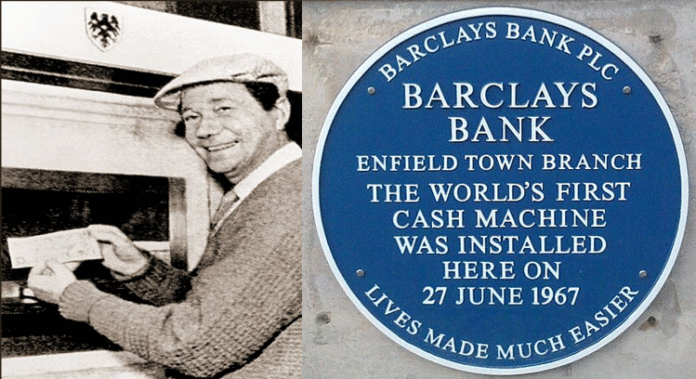
IT WAS on Tuesday 27th June 1967 – 50 years ago today – that Barclays Bank in Enfield, North London became the home of the world’s first cash machine.
The original idea for the cash machine came from John Shepherd-Barron of De La Rue Instruments, who was annoyed to arrive a minute after his branch had closed one Saturday and couldn’t get access to his money.
De La Rue offered the idea to Barclays, who leapt at the chance to develop the new technology. The machines were developed jointly by De La Rue Instruments and the bank’s Management Services Department, and were installed outside branches so that customers could obtain cash anytime, day or night.
The new service, known in those early days as Barclaycash was designed to dispense £10 against a special paper voucher which the customer inserted into the machine. By keying in a personal code number (initially 6 digits rather than 4), the customer could obtain cash in a matter of seconds.
Within two years, the first machine was ready. Enfield was chosen as the location due to its cross-section of population, a good pavement façade, high windows, and plentiful interior space. On 27th June, a crowd gathered to watch with bank officials and the Mayor of Enfield as TV comedy star most famous for his role as Stan Butler in On The Buses, Reg Varney, became the world’s first cash machine customer.
At first, just six such machines were installed at selected branches and, despite being the victim of vandalism at first, proved popular. Commentators immediately saw the potential of the ‘robot cashier’ and talked about installing them in airports and at railway stations, and of customers using them even when the bank was open.
By the 1970s, the machines had been refined in order to offer not only cash but also bank statements and deposit facilities as soon as the customer entered their card and PIN (Personal Identification Number).
On 30th June 1975, a more sophisticated auto teller machine (ATM), called Barclaybank was launched. The first two branches to offer the new machines were High Street and Cornmarket Street, Oxford. The machines were operated using a plastic card bearing the name Barclaybank.
In 1986, the ATMs of Barclays, Lloyds, Royal Bank of Scotland and Bank of Scotland were linked, enabling Barclaybank holders to make cash withdrawals from any of the four banks machines, with the West of England Building Society joining the reciprocal arrangement in 1988.
Barclaybank machines were not only installed outside branches: in 1986, a machine was unveiled at an NCR factory; in 1990, the 10,000th ATM built by NCR, a Barclaybank, was installed as a working exhibit in the Science Museum, Kensington; machines were installed in the House of Commons in 1990 and the House of Lords in 1996. The first ‘drive-thru’ cash machine in the UK was opened in May 1998 at Hatton Cross, near Heathrow Airport by Cheryl Baker, TV presenter. It joined the fastest growing network of ATMs in the country which by 1999 had reached 3,200.
Today, more than 80% of cash withdrawn from banks is obtained through cash machines. Of the 63,000 cash machines in the UK, more than 42,000 are situated away from bank branches.
The cash machine has become an indispensable part of modern life, and has certainly come a long way since Reg Varney opened the first one exactly fifty years ago.








